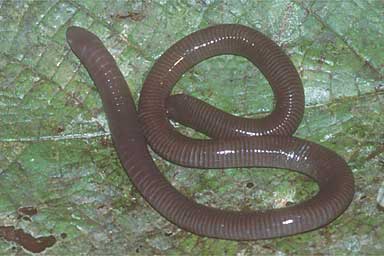Caecilian - Varagua
Purple Caecilian, Caecilian Worm Scientific Name: Gymnophis multiplicata
Mon, 28th April, 2025 - 12:21 pm GMT
Sponsor Ads:

Alternative Name
Purple Caecilian, Caecilian Worm Scientific Name: Gymnophis multiplicataBasic Info
The Varagua Caecilian is very distinct and unusual looking. They are limbless and grow to about 30 centimeters (1 foot) long. They have gigantic mouths, accompanied by nearly useless eyes. Their eyes are tiny and completely covered by skin. They have dark purple or black colored bodies. Varagua Caecilians have a retractable tentacle used for sensory purposes located between the eye and the nostril on either side of the body. Their bodies are grooved and their teeth and jaws are well developed. Males and females cannot be distinguished by external physical appearance.
Health
Varagua Caecilians imported from the wild may carry parasites. These often include roundworms, which may kill them if not tended to. Breeding Very few people have successfully bred the Varagua Caecilian in captivity. The female will give birth to several young, each around 5 inches long. The babies have thin white membranous "fins" on the backs of their heads. They are born in water and have gills, which they lose at maturity.Habitat
Muddy ground of the rainforests found in Central America, Asia, and Africa near the equator.Behavior
A mysterious creature in the wild, the Varagua Caecilian can be kept as a pet and should be a fascinating animal to any amphibian enthusiast. In the wild, the Varagua Caecilian is a very mysterious amphibian. Biologists have not gathered much information about these creatures, since they are hard to observe in the wild. They keep to themselves, digging burrows in the muddy ground of the rainforests found in Central America, Asia, and Africa near the equator. They survive on a diet of subterranean invertebrates, mostly worms and grubs. They spend the bulk of their lives underground, being flushed out yearly by heavy rains and retreating to safety when the rain subsides. In captivity, the Varagua Caecilian is a docile, quiet animal that is interesting to observe when you get the chance. They need an aquarium that is filled half with burrowing substrate and half with water. Try using gravel to create a little pool for them to bathe in and a big crumpled paper towel patch for them to burrow in. You won't really be able to watch them very often since they will spend the bulk of their time beneath the substrate. Brine shrimp are acceptable, and they will generally eat anything they can, but they may prefer some foods to others. They are known to live for either very short or very long periods of time. Some have lived less than two years, some more than 15. It's all in how you take care of them. The Varagua Caecilian is not easy to keep. They are known to host parasites and can die from having too many. Keep a close eye on them and any problems that arise should be taken care of as soon as possible.Origin
South AmericaHistory
The Varagua Caecilian is something of an enigma to biologists. It was at one time postulated that they were more closely related to frogs than salamanders, though today it is held that they are most closely related to salamanders. There is still a lot of debate about this topic. In the wild, they are rarely seen, making it difficult for biologists to study them. Since they are found commonly in pet stores, many people have tried to keep these exotic amphibians, but since they are so hard to keep, their popularity is limited. They were first noted in 1880, and may be threatened by rainforests destruction.Common Foods
Varagua Caecilians eat small invertebrates, earthworms, and amphibians.Sponsor Ads:
Boyys are capital fellows in their own way, among their mages; but they are unwholesome companions for grown people. --Charles Lamb
Caecilian - Varagua
Coded by: BGID® | ALL RIGHTS RESERVED Copyright © 2000-2025
Disclaimer | Privacy | Report Errors / Contact | Credits


 President of the United States of America - Real Estate mogul, Pageant owner and now one of the most controversial men in political history.
President of the United States of America - Real Estate mogul, Pageant owner and now one of the most controversial men in political history.  Politician, US Vice President and President of the USA - Joseph Robinette Biden Jr.
Politician, US Vice President and President of the USA - Joseph Robinette Biden Jr.  versus
versus  Russia: 'The Evil Empire'? Are they all that bad or is it just the USA trying to portray Russia as bad because they are a world power with land bigger and a society very different from the USA ideal?
Russia: 'The Evil Empire'? Are they all that bad or is it just the USA trying to portray Russia as bad because they are a world power with land bigger and a society very different from the USA ideal?  Global warming has been in and out as the "latest" hot topic for many years. It is, according to modern scientists, the result of man-made industrial pollutants, clearing forested areas, agriculture, etc. But now they are thinking it started way before the Industrial Revolution...
Global warming has been in and out as the "latest" hot topic for many years. It is, according to modern scientists, the result of man-made industrial pollutants, clearing forested areas, agriculture, etc. But now they are thinking it started way before the Industrial Revolution... 
 Corona virus
Corona virus 
 Users with wide screen monitors can benefit from more content on every page.
Users with wide screen monitors can benefit from more content on every page.